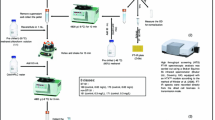Abstract
Statins are widely prescribed cholesterol-lowering medications and act through inhibition of the human enzyme 3-methylglutaryl coenzyme A reductase (HMG-R) which produces mevalonate (MVAL), a key substrate for cholesterol biosynthesis. Some important microbial species also express an isoform of HMG-R; however, the nature of the interaction between statins and bacteria is currently unclear and studies would benefit from protocols to quantify MVAL in complex microbial environments. The objective of this study was to develop a protocol for the analytical quantification of MVAL in bacterial systems and to utilise this approach to analyse the effects of Rosuvastatin (RSV) on bacterial MVAL formation. To determine the effective concentration range of RSV, we examined the dose-dependent inhibition of growth in the HMG-R+ bacterial pathogens Listeria monocytogenes, Staphylococcus aureus and Enterococcus faecium at various concentrations of pure RSV. Growth inhibition generally correlated with a reduction in bacterial MVAL levels, particularly in culture supernatants at high RSV concentrations, as determined using our ultra-performance liquid chromatography mass spectrometry protocol. This work therefore outlines a refined protocol for the analysis of MVAL in microbial cultures and provides evidence for statin-mediated inhibition of bacterial HMG-R. Furthermore, we show that MVAL is readily transported and secreted from bacterial cells into the growth media.





Similar content being viewed by others
References
Bergman P, Linde C, Putsep K, Pohanka A, Normark S, Henriques-Normark B, Andersson J, Bjorkhem-Bergman L (2011) Studies on the antibacterial effects of statins–in vitro and in vivo. PLoS One 6(8):e24394
Das R, Pal TK (2014) Validation of liquid chromatography-tandem mass spectrometry for mevalonate in human plasma: incompetent effects between treated atorvastatin & its combination with olmesartan in cardiovascular patients. J Young Pharm 6(2):50–57
Dueber JE, Wu GC, Malmirchegini GR, Moon TS, Petzold CJ, Ullal AV, Prather KL, Keasling JD (2009) Synthetic protein scaffolds provide modular control over metabolic flux. Nat Biotechnol 27(8):753–759
Emani S, Gunjiganur GV, Mehta DS (2014) Determination of the antibacterial activity of simvastatin against periodontal pathogens, Porphyromonas gingivalis and Aggregatibacter actinomycetemcomitans: an in vitro study. Contemp Clin Dent 5(3):377–382
Hennessy E, Mooij MJ, Legendre C, Reen FJ, O’Callaghan J, Adams C, O’Gara F (2013) Statins inhibit in vitro virulence phenotypes of Pseudomonas aeruginosa. J Antibiot 66(2):99–101
Hennessy E, O’Callaghan J, Mooij MJ, Legendre C, Camacho-Vanegas O, Camacho SC, Adams C, Martignetti JA, O’Gara F (2014) The impact of simvastatin on pulmonary effectors of Pseudomonas aeruginosa infection. PLoS One 9(7):e102200
Heuston S, Begley M, Davey MS, Eberl M, Casey PG, Hill C, Gahan CG (2012) HmgR, a key enzyme in the mevalonate pathway for isoprenoid biosynthesis, is essential for growth of Listeria monocytogenes EGDe. Microbiology 158(Pt 7):1684–1693
Heuston S, Begley M, Gahan CG, Hill C (2012) Isoprenoid biosynthesis in bacterial pathogens. Microbiology 158(Pt 6):1389–1401
Istvan ES (2002) Structural mechanism for statin inhibition of 3-hydroxy-3-methylglutaryl coenzyme A reductase. Am Heart J 144(6 Suppl):S27–S32
Jerwood S, Cohen J (2008) Unexpected antimicrobial effect of statins. J Antimicrob Chemother 61(2):362–364
Johansen ME, Green LA, Sen A, Kircher S, Richardson CR (2014) Cardiovascular risk and statin use in the United States. Ann Fam Med 12(3):215–223
Lange BM, Rujan T, Martin W, Croteau R (2000) Isoprenoid biosynthesis: the evolution of two ancient and distinct pathways across genomes. Proc Natl Acad Sci USA 97(24):13172–13177
Lombard J, Moreira D (2011) Origins and early evolution of the mevalonate pathway of isoprenoid biosynthesis in the three domains of life. Mol Biol Evol 28(1):87–99
Masadeh M, Mhaidat N, Alzoubi K, Al-Azzam S, Alnasser Z (2012) Antibacterial activity of statins: a comparative study of atorvastatin, simvastatin, and rosuvastatin. Ann Clin Microbiol Antimicrob 11:13
Matsuoka T, Ueda S, Matsumoto H, Kawakami M (2012) An ultrasensitive enzymatic method for measuring mevalonic acid in serum. J Lipid Res 53(9):1987–1992
Motzkus-Feagans CA, Pakyz A, Polk R, Gambassi G, Lapane KL (2012) Statin use and the risk of Clostridium difficile in academic medical centres. Gut 61(11):1538–1542
Park SW, Choi AR, Lee HJ, Chung H, Park JC, Shin SK, Lee SK, Lee YC, Kim JE, Lee H (2013) The effects of statins on the clinical outcomes of Clostridium difficile infection in hospitalised patients. Aliment Pharmacol Ther 38(6):619–627
Tabernero L, Rodwell VW, Stauffacher CV (2003) Crystal structure of a statin bound to a class II hydroxymethylglutaryl-CoA reductase. J Biol Chem 278(22):19933–19938
Tauch A, Bischoff N, Puhler A, Kalinowski J (2004) Comparative genomics identified two conserved DNA modules in a corynebacterial plasmid family present in clinical isolates of the opportunistic human pathogen Corynebacterium jeikeium. Plasmid 52(2):102–118
Waldron J, Webster C (2011) Liquid chromatography-tandem mass spectrometry method for the measurement of serum mevalonic acid: a novel marker of hydroxymethylglutaryl coenzyme A reductase inhibition by statins. Ann Clin Biochem 48(Pt 3):223–232
Acknowledgments
J.A.N. was funded by an EMBARK postgraduate research scholarship from the Irish Research Council for Science Engineering and Technology (IRCSET). The mass spectrometry instrument and analysis was funded under the Higher Education Authority Programme for Research in Third Level Institutions (PRTLI), cycle 4 and co-funded under the European Regional Development Fund. This publication has emanated from research conducted with the financial support of Science Foundation Ireland (SFI) under Grant Number SFI/12/RC/2273.
Author information
Authors and Affiliations
Corresponding authors
Ethics declarations
Conflict of Interest
No conflict of interest declared.
Electronic supplementary material
Below is the link to the electronic supplementary material.
284_2016_1014_MOESM1_ESM.docx
Figure S1. UPLC-MS standard curve of MVAL. Figure S2. Elution of MVAL at 2.1 mins at 12.5 ng/ml giving a limit of detection (LOD) of 3.125 ng/ml. Figure S3. CLUSTAL (MUSCLE) alignment of C. kroppenstedtii (Class I HMG-R) against S. aureus (Class II HMG-R) revealed low sequence identity (20.06%) and regions of dissimilarity. Supplementary material 1 (DOCX 468 kb)
Rights and permissions
About this article
Cite this article
Nolan, J.A., Kinsella, M., Hill, C. et al. Analysis of the Impact of Rosuvastatin on Bacterial Mevalonate Production Using a UPLC-Mass Spectrometry Approach. Curr Microbiol 73, 1–8 (2016). https://doi.org/10.1007/s00284-016-1014-z
Received:
Accepted:
Published:
Issue Date:
DOI: https://doi.org/10.1007/s00284-016-1014-z




